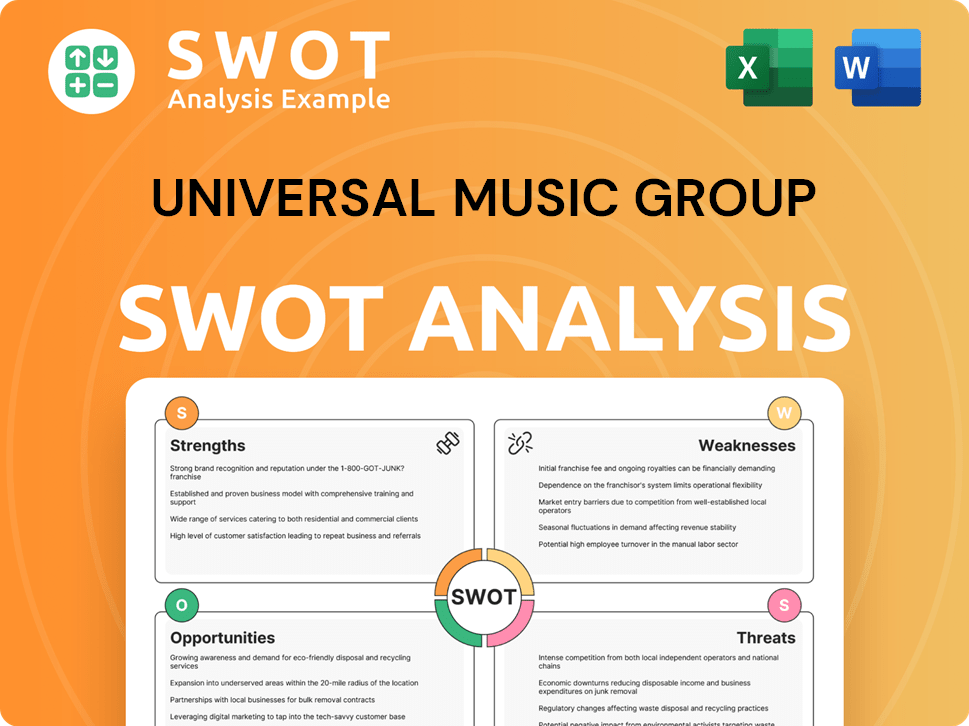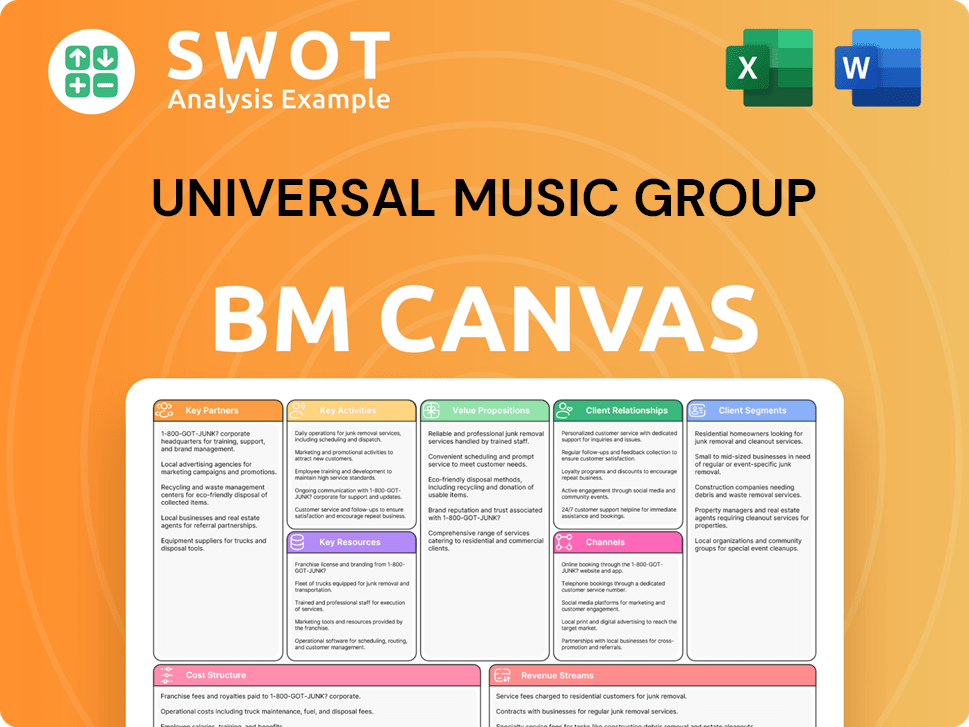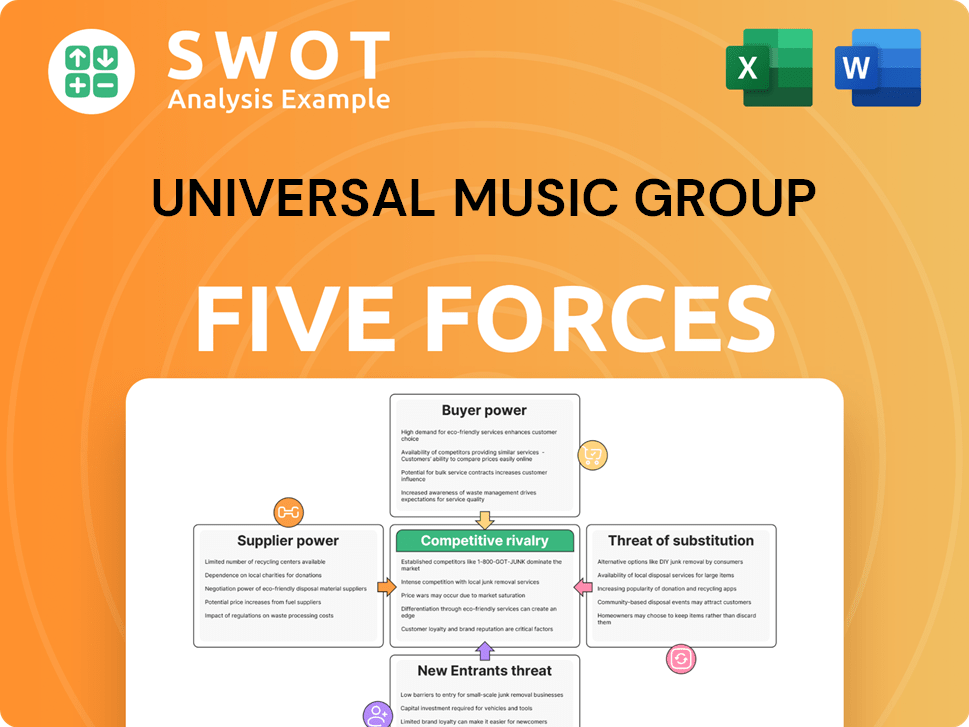Universal Music Group Bundle
How Does Universal Music Group Dominate the Music Industry?
In an era where music consumption is constantly evolving, understanding the Universal Music Group SWOT Analysis is crucial for any investor or industry observer. Universal Music Group (UMG) isn't just a company; it's a global powerhouse shaping the soundscape of our times. But how does UMG maintain its dominance amid fierce competition and rapid technological change?

This exploration of the UMG competitive landscape delves into the strategies, rivals, and market dynamics that define its success. We'll dissect UMG's position in the music market, analyzing its competitive advantages and how it navigates the impact of streaming on its business. From comparing UMG with its major music labels competitors to examining its global presence, this analysis provides actionable insights for anyone interested in the future of music labels competition and UMG's market share analysis.
Where Does Universal Music Group’ Stand in the Current Market?
Universal Music Group (UMG) holds a significant position in the global music industry, recognized as one of the 'Big Three' record labels. This places UMG in a strong position within the music industry competition. UMG's core operations involve recorded music, music publishing, merchandising, and audiovisual content. The company's value proposition lies in its extensive catalog of music assets, encompassing a vast library of recordings from iconic artists across diverse genres. This diverse portfolio caters to a wide range of music enthusiasts, providing a competitive edge in the market.
UMG's global reach, with operations in over 60 countries, is a key factor in its market dominance. This widespread presence allows UMG to tap into diverse markets worldwide, maximizing revenue streams in various regions. The company has shown strong growth in high-potential markets such as Japan, Germany, China, and Mexico, which are now among its top 10 markets by subscription revenue. UMG's ability to adapt and thrive in different cultural and economic landscapes contributes to its sustained success.
UMG's financial performance reflects its strong market position. For the first quarter of 2025, UMG reported total revenue of €2,901 million (approximately $3.30 billion), an increase of 11.8% year-over-year, or 9.5% in constant currency. Recorded Music revenue for Q1 2025 was €2,241 million, up 12.7% year-over-year, or 10.3% in constant currency. Subscription revenue, a significant driver of growth, increased by 11.5% year-over-year in Q1 2025, or 9.3% in constant currency, fueled by growth in global subscribers and price increases. Adjusted EBITDA for Q1 2025 grew 10% year-over-year to €661 million, maintaining a steady margin of 22.8%.
UMG, along with Sony Music Entertainment and Warner Music Group, controls over 85% of the U.S. recording music industry. This strong market share is a key indicator of UMG's dominance. The company's vast catalog and global presence contribute to its competitive advantages.
UMG's Q1 2025 results showed robust financial health. Total revenue reached €2,901 million, with recorded music revenue at €2,241 million. Subscription revenue growth was a significant driver, increasing by 11.5% year-over-year. These figures demonstrate UMG's ability to capitalize on the growth of music streaming services.
UMG operates in over 60 countries, giving it a strong global reach. The company focuses on high-potential markets like Japan, Germany, China, and Mexico. This global strategy allows UMG to diversify its revenue streams and maintain a competitive edge in the music industry competition.
UMG anticipates an 8-10% compound annual growth rate for music streaming subscriptions from 2023 to 2028. This projected growth highlights the importance of streaming services. This growth is a key factor in UMG's future success and its ability to compete in the music market.
UMG's competitive advantages include its extensive music catalog, global presence, and strong financial performance. These factors enable UMG to maintain a leading position in the music industry. For more insights, consider reading a Brief History of Universal Music Group.
- Vast and Diverse Music Catalog: UMG's extensive library of recordings across various genres attracts a broad audience.
- Global Operations: UMG's presence in over 60 countries allows it to tap into diverse markets and maximize revenue.
- Strong Financial Performance: Consistent revenue growth and healthy profit margins support UMG's investments and market position.
- Strategic Investments: UMG's investments in high-growth markets and streaming services drive future success.
Universal Music Group SWOT Analysis
- Complete SWOT Breakdown
- Fully Customizable
- Editable in Excel & Word
- Professional Formatting
- Investor-Ready Format

Who Are the Main Competitors Challenging Universal Music Group?
The Universal Music Group (UMG) competitive landscape is primarily defined by its rivalry with other major players in the music industry. The music market is a dynamic environment, and music industry competition is fierce, with companies continually vying for market share and dominance. Understanding the competitive dynamics is crucial for assessing UMG's strategic positioning and future prospects.
Universal Music Group operates in a highly competitive environment. The UMG competitive landscape includes both traditional major labels and a growing number of independent entities. The company's strategies must adapt to the evolving nature of music consumption and distribution, including the rise of streaming services and digital platforms.
Universal Music Group faces competition from a variety of sources, including other major labels, independent labels, and digital platforms. UMG's position in the music market is influenced by its ability to secure and promote talent, manage its catalog, and adapt to changes in technology and consumer behavior. The company must continuously innovate and adapt to maintain its competitive edge.
The most direct competitors to UMG are Sony Music Entertainment and Warner Music Group. These three companies, often referred to as the 'Big Three,' dominate the global music market. They compete in artist signing, promotion, music distribution, and publishing.
Sony Music Entertainment is a major global music company with an extensive roster of artists and music labels. It directly competes with UMG in artist signing and promotion, as well as in music distribution and publishing. These major competitors constantly vie for market share, talent, and lucrative deals.
Warner Music Group is another substantial player, holding a strong presence in both recorded music and music publishing. The company focuses on signing and developing new talent. These major competitors constantly vie for market share, talent, and lucrative deals.
A growing number of independent labels also challenge UMG. The digital transformation of the music industry has simplified the route to market for new entrants, leading to a proliferation of independent labels. Emerging companies like Believe, EMPIRE, and Create Music Group have leveraged digital distribution channels to gain significant market share.
Digital music platforms such as Apple Music, Spotify, and Amazon pose significant competition by offering alternative platforms for music consumption. UMG's negotiating power with streaming platforms was tested during a licensing dispute with TikTok in Q1 2024, though UMG managed to increase royalty rates and strengthen protections against AI-generated content.
The competitive landscape is further impacted by mergers and alliances. For example, UMG's acquisition of the remaining share of [PIAS] and investment in Mavin Global in Nigeria demonstrate its strategy to expand its geographic footprint and artist services.
UMG's strategies for market dominance involve several key elements. These include artist acquisition and development, effective promotion and marketing, robust distribution networks, and adaptation to technological changes. Competition in the music industry is multifaceted, with companies vying for dominance through various strategies.
- Market Share: The 'Big Three' continuously compete for market share, with Sony Music Entertainment and Warner Music Group being key rivals.
- Artist Roster: The quality and diversity of an artist roster are crucial. UMG's ability to attract and retain top talent is a key competitive advantage.
- Distribution and Streaming: Securing favorable deals with streaming services and optimizing distribution channels are critical. UMG's negotiations with platforms like TikTok highlight this.
- Innovation and Technology: Adapting to new technologies and business models, such as AI-generated content, is essential for staying competitive.
- Global Presence: Expanding into new markets and strengthening existing ones, as seen with UMG's investments in regions like Africa, is important for growth.
Universal Music Group PESTLE Analysis
- Covers All 6 PESTLE Categories
- No Research Needed – Save Hours of Work
- Built by Experts, Trusted by Consultants
- Instant Download, Ready to Use
- 100% Editable, Fully Customizable

What Gives Universal Music Group a Competitive Edge Over Its Rivals?
Understanding the UMG competitive landscape requires a look at its core strengths. Universal Music Group (UMG) stands out due to its extensive music catalog, encompassing a wide array of artists and genres. This vast intellectual property is a major asset, giving UMG a significant edge in the music industry competition.
Another key factor is UMG's strong relationships with artists. Representing many of the world's most successful musicians, UMG has a solid foundation for attracting and keeping top talent. Its global reach and distribution network also play a crucial role. With a presence in over 60 countries, UMG can reach audiences worldwide, maximizing its revenue streams.
Technological innovation is also a focus. UMG invests in digital distribution and data analytics to understand consumer preferences. Initiatives like the UMG Accelerator Engagement Network and Abbey Road RED Incubator foster innovation. These advantages have evolved with the shift towards digital consumption, influencing marketing and strategic partnerships. For more insights into the company's financial performance, consider exploring Revenue Streams & Business Model of Universal Music Group.
UMG's extensive catalog includes recordings from iconic artists across various genres. This diverse portfolio allows UMG to capitalize on different market segments and trends. This broad selection of music provides a significant competitive advantage in the music industry competition.
UMG represents many of the most successful and influential artists globally. This gives it a significant edge in attracting and retaining top talent. Strong relationships with artists, labels, and industry partners enhance its market position.
With operations in over 60 countries, UMG can reach audiences worldwide. This global presence allows the company to tap into new sources of revenue. This enhances its ability to compete in the global UMG competitive landscape.
UMG embraces digital innovation, investing in digital distribution and data analytics. Initiatives like the UMG Accelerator Engagement Network foster new talent and drive innovation. This focus on technology is crucial for maintaining a competitive edge.
UMG's competitive advantages include its extensive catalog, artist relationships, global reach, and technological innovation. These factors contribute to its strong position in the music industry competition. These advantages are generally sustainable due to the scale of UMG's operations and its continuous investment in talent and technology.
- Vast and diverse music catalog, including recordings from iconic artists.
- Strong artist roster and relationships, attracting and retaining top talent.
- Global reach and distribution network, maximizing revenue streams worldwide.
- Technological innovation and adaptation, including digital distribution and data analytics.
Universal Music Group Business Model Canvas
- Complete 9-Block Business Model Canvas
- Effortlessly Communicate Your Business Strategy
- Investor-Ready BMC Format
- 100% Editable and Customizable
- Clear and Structured Layout

What Industry Trends Are Reshaping Universal Music Group’s Competitive Landscape?
The music industry's competitive landscape is rapidly evolving, significantly impacting Universal Music Group (UMG). UMG must navigate digital disruption, technological advancements, and regulatory changes to maintain its market position. Understanding these dynamics is crucial for evaluating UMG's strategic direction and future prospects.
UMG's position in the music market is influenced by its ability to adapt to industry trends, manage risks, and capitalize on opportunities. The company's financial performance, artist roster, and global presence are key factors in its competitive strategy. Analyzing the competitive landscape helps assess UMG's strengths, weaknesses, and potential for growth.
Digital streaming platforms like Spotify, Apple Music, and Amazon Music are dominating how consumers access music. UMG needs to adapt its distribution strategies to leverage the growth of streaming. In Q1 2025, UMG's subscription revenue grew by 11.5% year-over-year, or 9.3% in constant currency, highlighting the importance of this shift.
Technological advancements, particularly AI, are reshaping the competitive environment. UMG faces challenges from AI music, which could demonetize users, and short-form video platforms like TikTok, whose monetization models are less robust. Regulatory changes concerning intellectual property rights are also crucial for protecting UMG's extensive music catalog.
Expansion into emerging markets offers significant growth potential. Diversifying revenue streams beyond recorded music through music publishing, live events, and brand partnerships is key. UMG is exploring 'super-premium' subscription tiers with DSPs to increase average revenue per user (ARPU).
UMG's strategy includes artist development, diversified revenue streams, and global expansion. The company invests in digital innovation and strategic partnerships. UMG's restructuring of country music operations demonstrates its adaptive approach. Analysts project UMG's revenue to grow by 6.5% annually over the next three years.
The UMG competitive landscape is shaped by digital transformation, technological advancements, and regulatory changes. UMG's ability to navigate these factors will determine its success. Understanding the music industry competition and UMG's strategic responses is essential for evaluating its future.
- Market Share Music Industry: UMG competes with major music labels and independent labels.
- Streaming Services: UMG must adapt to the dominance of music streaming services.
- Global Presence: UMG's global presence and expansion into emerging markets are crucial.
- Revenue Diversification: Diversifying revenue streams is a key strategy for UMG.
Universal Music Group Porter's Five Forces Analysis
- Covers All 5 Competitive Forces in Detail
- Structured for Consultants, Students, and Founders
- 100% Editable in Microsoft Word & Excel
- Instant Digital Download – Use Immediately
- Compatible with Mac & PC – Fully Unlocked

Related Blogs
- What are Mission Vision & Core Values of Universal Music Group Company?
- What is Growth Strategy and Future Prospects of Universal Music Group Company?
- How Does Universal Music Group Company Work?
- What is Sales and Marketing Strategy of Universal Music Group Company?
- What is Brief History of Universal Music Group Company?
- Who Owns Universal Music Group Company?
- What is Customer Demographics and Target Market of Universal Music Group Company?
Disclaimer
All information, articles, and product details provided on this website are for general informational and educational purposes only. We do not claim any ownership over, nor do we intend to infringe upon, any trademarks, copyrights, logos, brand names, or other intellectual property mentioned or depicted on this site. Such intellectual property remains the property of its respective owners, and any references here are made solely for identification or informational purposes, without implying any affiliation, endorsement, or partnership.
We make no representations or warranties, express or implied, regarding the accuracy, completeness, or suitability of any content or products presented. Nothing on this website should be construed as legal, tax, investment, financial, medical, or other professional advice. In addition, no part of this site—including articles or product references—constitutes a solicitation, recommendation, endorsement, advertisement, or offer to buy or sell any securities, franchises, or other financial instruments, particularly in jurisdictions where such activity would be unlawful.
All content is of a general nature and may not address the specific circumstances of any individual or entity. It is not a substitute for professional advice or services. Any actions you take based on the information provided here are strictly at your own risk. You accept full responsibility for any decisions or outcomes arising from your use of this website and agree to release us from any liability in connection with your use of, or reliance upon, the content or products found herein.